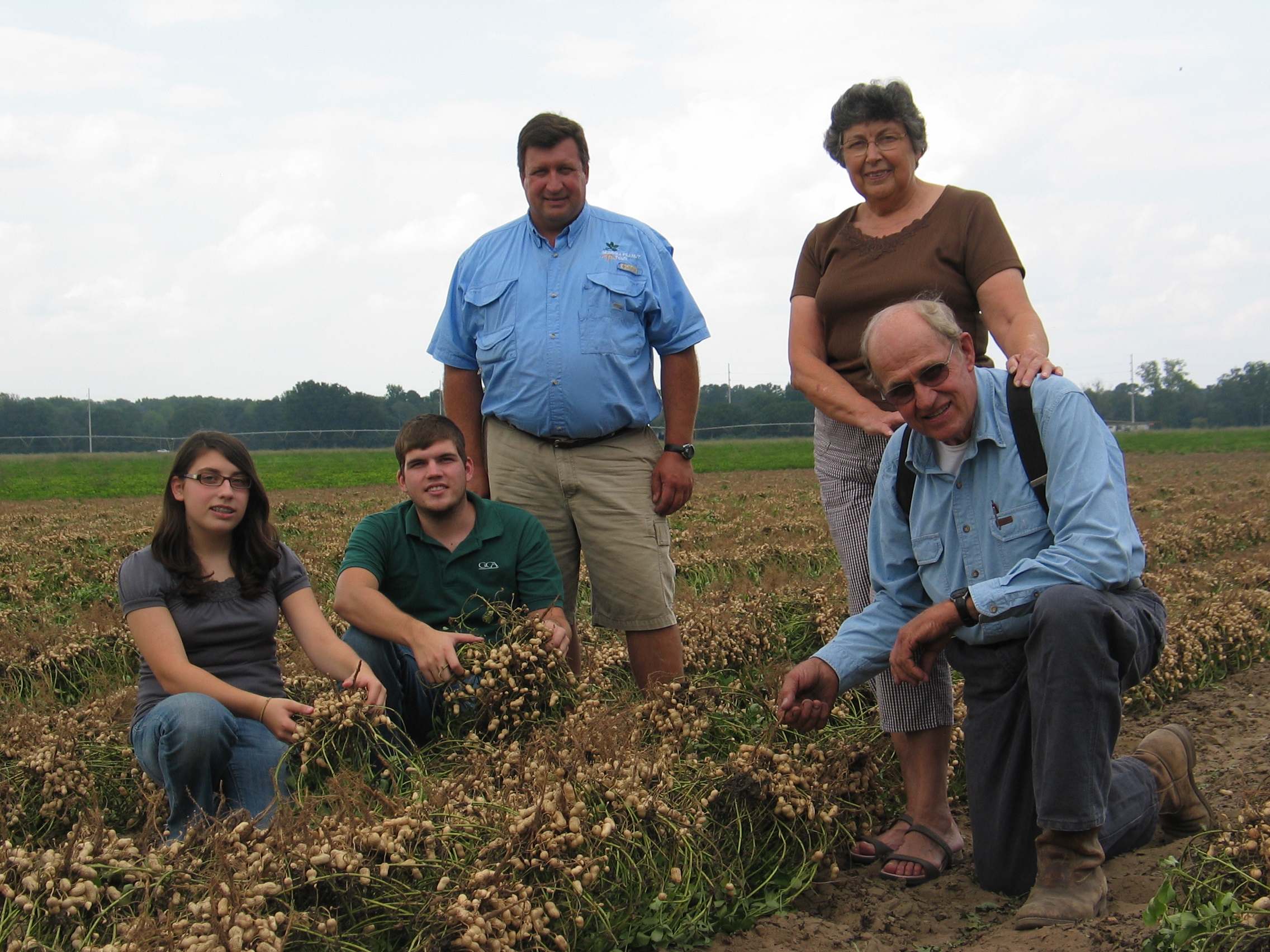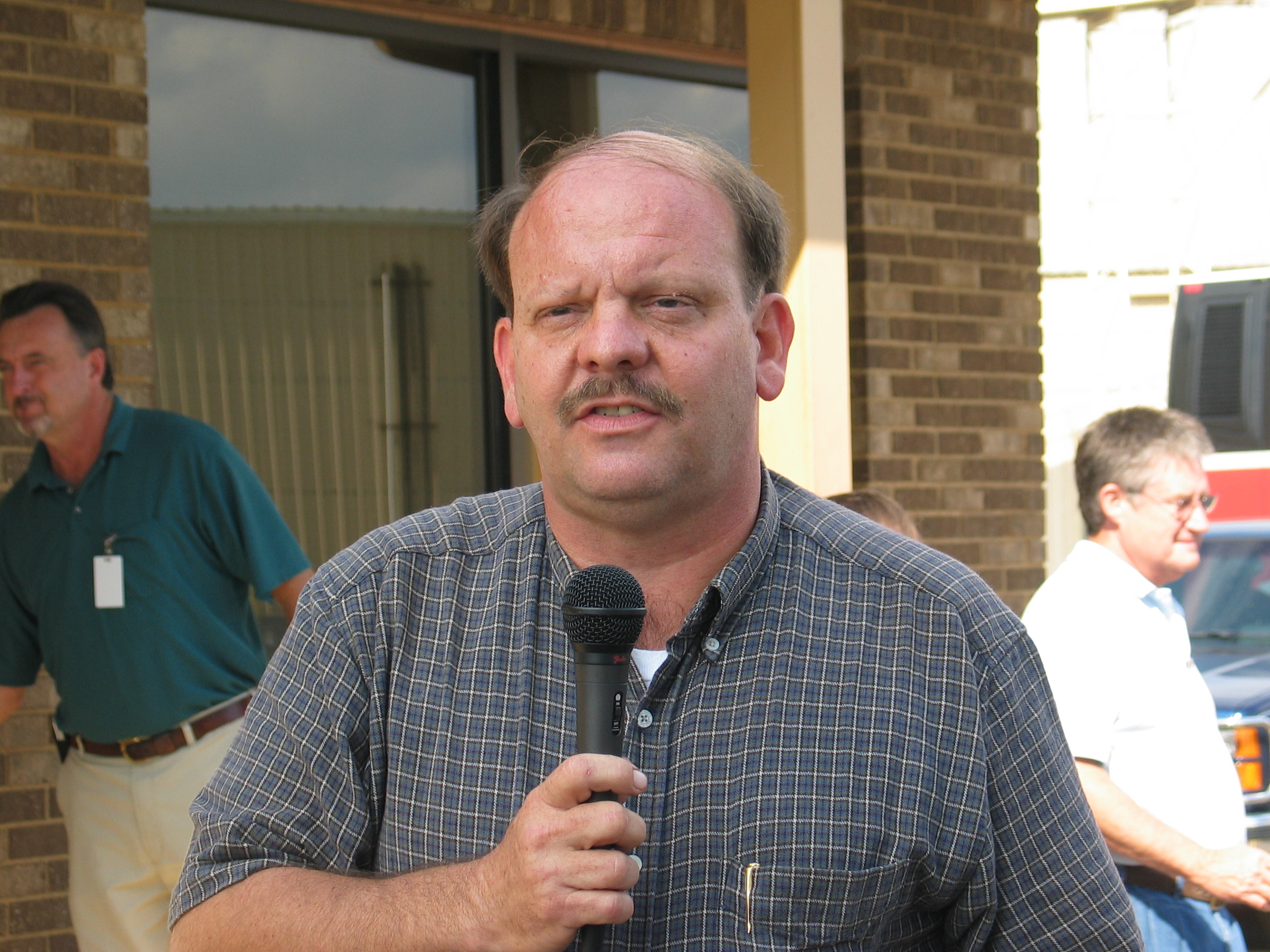 Lee County – Doug Collins, Lee County Extension Coordinator, says the peanut crop in Lee County looks good this year. Farmers planted approximately 12,000 acres of peanuts and Collins estimates production at 16,800 tons. This year farmers in the north end of the county have been faced with drought while all farmers have had trouble with pigweed control. Farmers in Lee County also grow cotton, corn, wheat and pecans. Collins met the Georgia Peanut Tour group at McCleskey Mills, a shelling plant in Smithville, Ga. Learn more about Lee County online at this web site.
Lee County – Doug Collins, Lee County Extension Coordinator, says the peanut crop in Lee County looks good this year. Farmers planted approximately 12,000 acres of peanuts and Collins estimates production at 16,800 tons. This year farmers in the north end of the county have been faced with drought while all farmers have had trouble with pigweed control. Farmers in Lee County also grow cotton, corn, wheat and pecans. Collins met the Georgia Peanut Tour group at McCleskey Mills, a shelling plant in Smithville, Ga. Learn more about Lee County online at this web site.
Georgia Peanut Tour visits McCleskey Mills
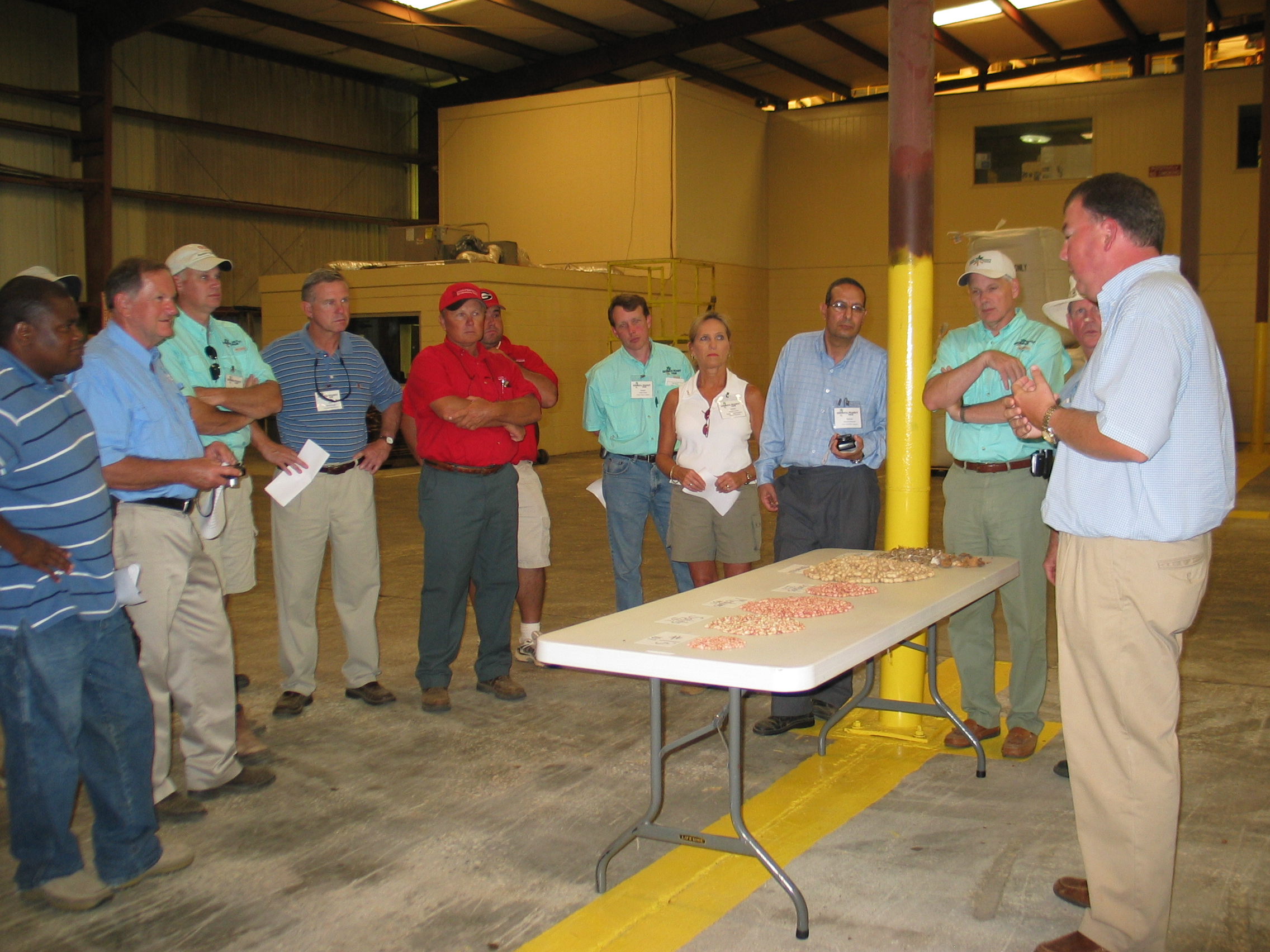 The Georgia Peanut tour visited McCleskey Mills in Smithville, Ga. McCleskey Mills is a family owned operation that shells about 100,000 tons of farmerstock peanuts annually which is generated by 15 buying stations in Georgia, Florida and Alabama. The three shift operation provides a portion of the needs for the world’s major peanut butter, candy, confectioners, as well as salted nut roasters. Being home-owned and managed, McCleskey is able to make on-the-spot decisions and offers its’ grower customers competitive markets, and manufacturer customers the industry’s highest quality shelled peanuts in bags, boxes or bulk containers. The company’s seed peanut program grows and distributes high quality seed in the Southeast, and enjoys a reputation second to none. This was a great stop for the Peanut Tour for group members were able to see what happens to the peanut crop once it leaves the farm and enters a shelling plant. Thanks to McCleskey Mills for all that they do for the ever growing peanut industry!
The Georgia Peanut tour visited McCleskey Mills in Smithville, Ga. McCleskey Mills is a family owned operation that shells about 100,000 tons of farmerstock peanuts annually which is generated by 15 buying stations in Georgia, Florida and Alabama. The three shift operation provides a portion of the needs for the world’s major peanut butter, candy, confectioners, as well as salted nut roasters. Being home-owned and managed, McCleskey is able to make on-the-spot decisions and offers its’ grower customers competitive markets, and manufacturer customers the industry’s highest quality shelled peanuts in bags, boxes or bulk containers. The company’s seed peanut program grows and distributes high quality seed in the Southeast, and enjoys a reputation second to none. This was a great stop for the Peanut Tour for group members were able to see what happens to the peanut crop once it leaves the farm and enters a shelling plant. Thanks to McCleskey Mills for all that they do for the ever growing peanut industry!
Donald Chase talks peanut production
MVI_8707
Originally uploaded by Georgia Peanut Commission
Donald Chase, Macon County peanut farmer and Georgia Peanut Commission board member, discusses his farm operation to the Georgia Peanut Tour attendees on Thursday, Sept. 18, 2008. Chase describes peanut production on Chase Farms this year including information on fungicide sprays, weed control methods and how they harvest using GPS.
Video of Peanut Digging at the Chase Farm
MVI_8710
Originally uploaded by Georgia Peanut Commission
Glenn Lee Chase, farmer from Macon County, Ga., showcases how to dig peanuts to the Georgia Peant Tour. Chase is using GPS autosteer and also has a mower attached to the front of the tractor that cuts the top of the peanut plants prior to digging. The Chase farm has applied this technique to help the peanut vines stand up better in the field after digging.
Visit to Chase Farms
Georgia Peanut Tour attendees were able to see harvest first-hand at the Chase family farm in Macon County, Georgia. Glenn Lee Chase started digging peanuts where everyone on the tour could see how peanuts are harvested. The Chase family uses GPS to help guide the digger through the field and minimize loss at digging. The family operation also consists of sweet corn, field corn, and broiler houses. Donald represents farmers in his area as a board member of the Georgia Peanut Commission. The farm is a family operation of Glenn Lee & Ellen Chase and their son Donald, his wife, Michelle, and their three kids, Marilee, Laura and Greg.
Sumter & Macon County Agriculture Update
 Sumter County – Bill Starr, Sumter County Extension Coordinator, provided an update on the peanut crop in Sumter County to the Georgia Peanut Tour group. Sumter County farmers planted approximately 10,000 acres of peanuts this year. The average yield is around 3,600 pounds per acre. Other crops grown in Sumter County include cotton, corn and vegetables. Farmers in the area experienced problems early in the growing season with weeds and later on with white mold. According to Starr the peanut crop looks very good this year with some fields looking excellent in Sumter County.
Sumter County – Bill Starr, Sumter County Extension Coordinator, provided an update on the peanut crop in Sumter County to the Georgia Peanut Tour group. Sumter County farmers planted approximately 10,000 acres of peanuts this year. The average yield is around 3,600 pounds per acre. Other crops grown in Sumter County include cotton, corn and vegetables. Farmers in the area experienced problems early in the growing season with weeds and later on with white mold. According to Starr the peanut crop looks very good this year with some fields looking excellent in Sumter County.
Macon County – Jeremy Kichler, Macon County Extension Coordinator, provided an update on Macon to the Georgia Peanut Tour group. This year Macon County farmers planted 5,956 acres of peanuts and Kichler estimates production at 1.5 tons per acre for dryland peanuts and 2 tons per acre for irrigated peanuts. Sixty percent of the acreage in Macon County is irrigated with 40 percent dryland. In addition to peanuts, Macon County farmers also grow corn, corn silage, cotton, peaches and vegetables. There are also 36 dairies in the county. Macon County farmers have had a difficult year with Glyphosate-Resistant and ALS-Resistant Palmer Amaranth (pigweed). Overall the peanut crop is looking good though.
Planting Date Study
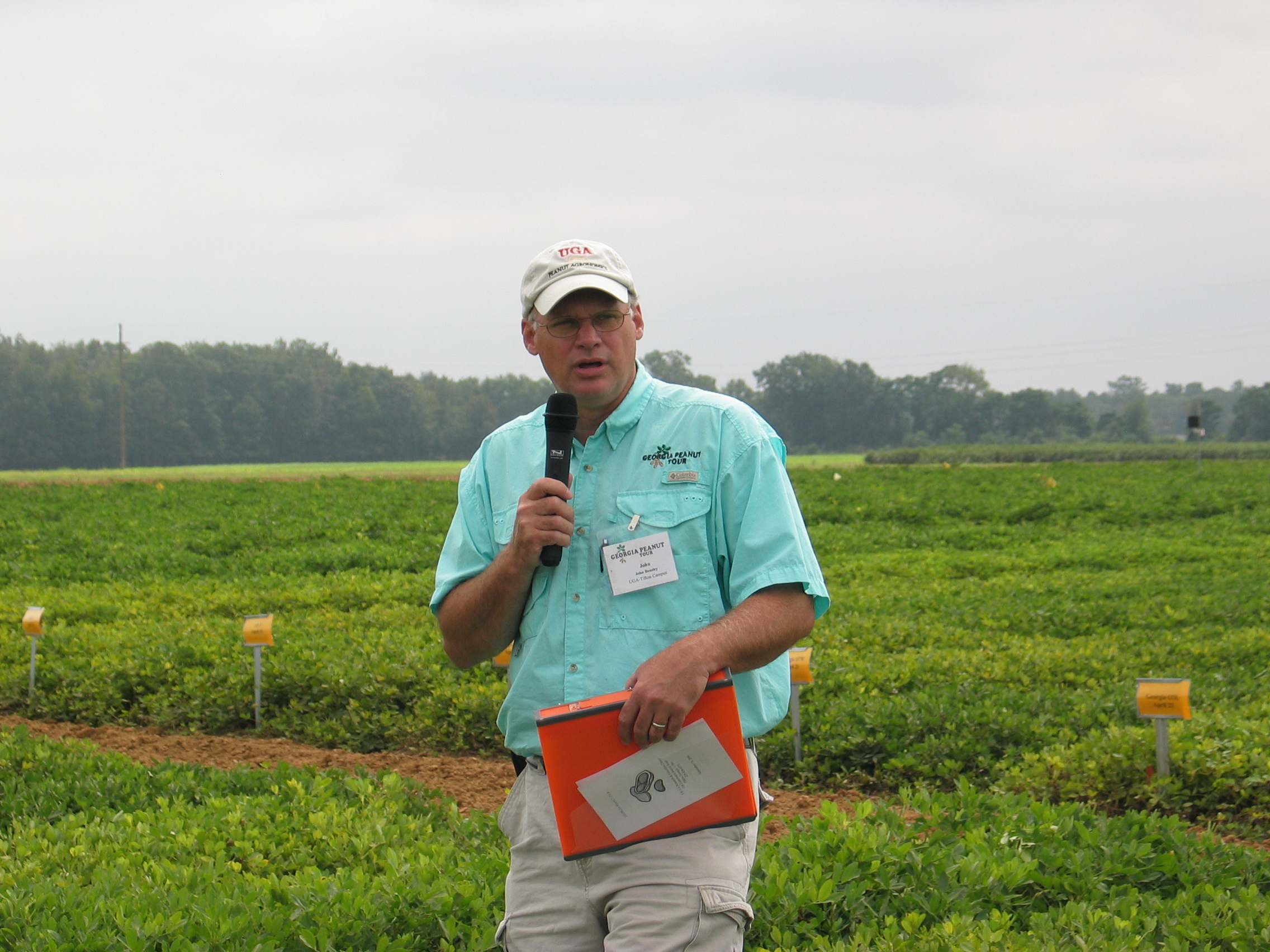 In addition to the amount of seed planted per foot of row the date of planting can be just as important. According to John Beasley, University of Georgia peanut agronomist, many farmers started planting peanuts later in the spring due to tomato spotted wilt virus in peanuts. Also, research results have shown that the optimum time for planting peanuts is around the first couple of weeks in May in order to reduce the risk of disease and tomato spotted wilt virus. In fact today approximately 95 percent of the peanut crop is planted in the month of May. The later planting date helps when fighting disease pressure but is a logistical problem at harvest in the fall for farmers that grow peanuts and cotton. In fact, Beasley says the quality of cotton in Georgia has suffered some. Farmers have to make a decision at harvest when both crops are ready and in some cases the farmers choose to harvest their peanuts first since it is more perishable commodity. Today, there are many new cultivars that were not available for farmers a few years ago so researchers are revisiting the planting date to see if some of the new cultivars could be planted in April without increasing the risk of disease pressure. In this research study, peanuts were planted on April 21 and May 20 at the Southwest Georgia Research and Education Center. Research is also ongoing at the University of Georgia research stations in Attapulgus and Midville. Hopefully, this research will find a way to help farmers with logistics at harvest.
In addition to the amount of seed planted per foot of row the date of planting can be just as important. According to John Beasley, University of Georgia peanut agronomist, many farmers started planting peanuts later in the spring due to tomato spotted wilt virus in peanuts. Also, research results have shown that the optimum time for planting peanuts is around the first couple of weeks in May in order to reduce the risk of disease and tomato spotted wilt virus. In fact today approximately 95 percent of the peanut crop is planted in the month of May. The later planting date helps when fighting disease pressure but is a logistical problem at harvest in the fall for farmers that grow peanuts and cotton. In fact, Beasley says the quality of cotton in Georgia has suffered some. Farmers have to make a decision at harvest when both crops are ready and in some cases the farmers choose to harvest their peanuts first since it is more perishable commodity. Today, there are many new cultivars that were not available for farmers a few years ago so researchers are revisiting the planting date to see if some of the new cultivars could be planted in April without increasing the risk of disease pressure. In this research study, peanuts were planted on April 21 and May 20 at the Southwest Georgia Research and Education Center. Research is also ongoing at the University of Georgia research stations in Attapulgus and Midville. Hopefully, this research will find a way to help farmers with logistics at harvest.
Research on Seeding Rates at Planting
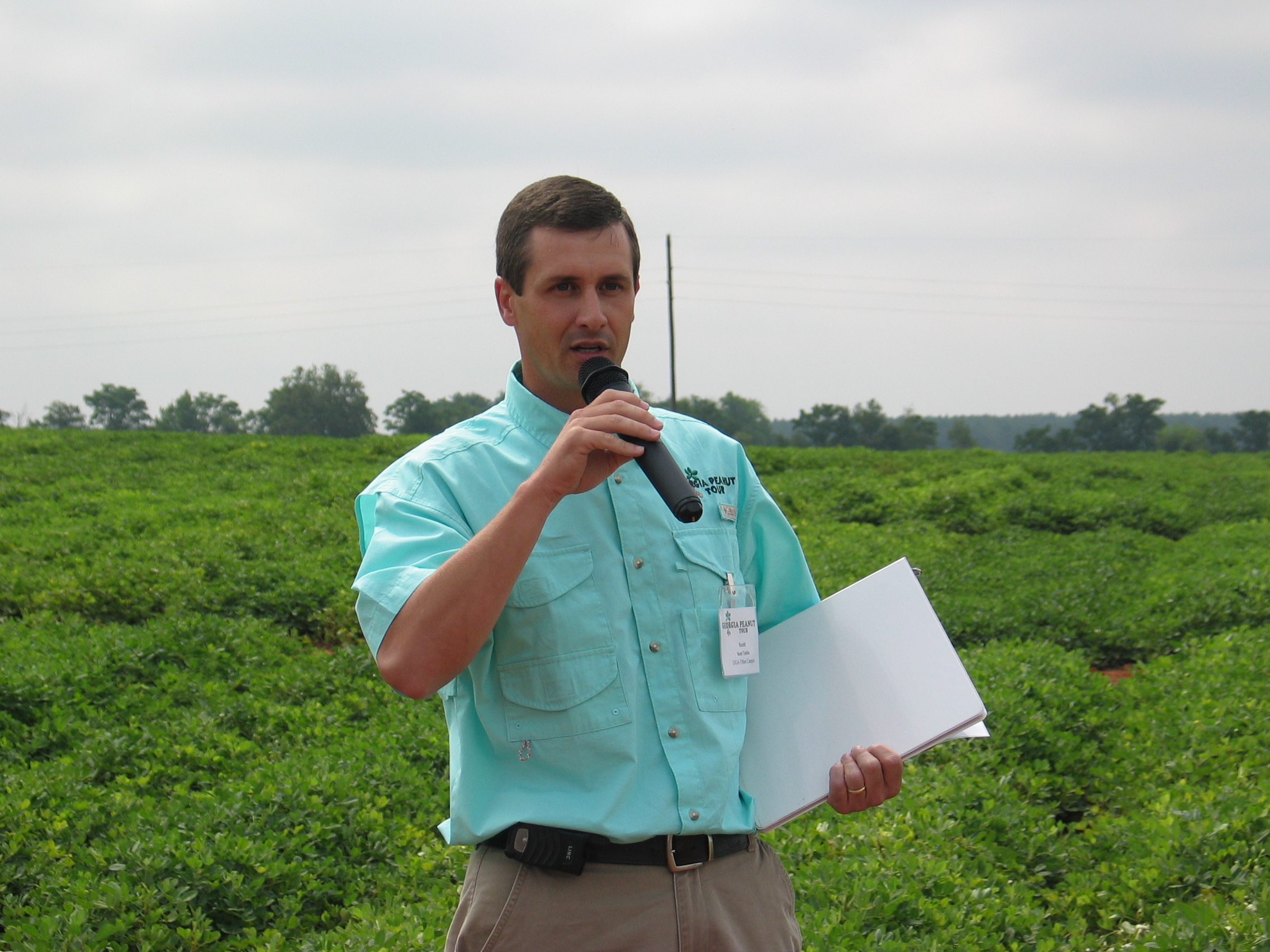 Scott Tubbs, University of Georgia cropping systems agronomist, discussed the first year of a research study looking at increasing or decreasing seed per foot when planting and the effect this how on the risk of disease. There were 42 treatments per repetition using various seeding rates on single and twin rows. Tubbs planted the following varieties in the test: Florida 07, Tifguard, AP3, Georgia-03L, AT3085RO, Georgia-06G and Georgia Green. The varieties were planted at the recommended rate of 6 seed per foot on single or 3 seed per foot on twin rows. The 6 seed per foot equals 4 plants per stand. Then in the research trial the varieties were also planted by increasing the seed per foot by one seed to 7 and decreasing the seed per foot by one seed to 5. Results have shown that when the seed per foot has been reduced then there has been an increase in tomato spotted wilt virus. Also, when the seed per foot has been increased then there has been an increase in white mold. There are also similar studies like this at the University of Georgia research stations in Attapulgus and Midville. The tests in Attapulgus is looking at even higher rates of seed per foot while the Midville test is looking at lower rates of seed per foot. In one variety, Georgia Green, growers use 87,522 seed per acre when planting 6 seed per foot, 73,000 per acre when planting 5 seed per foot and 102,000 seed per acre when planting 7 seed per foot. If a farmer is able to decrease the seeding rate at planting then they could potentially save $16.00 to $20.00. The research should be able to shed some new light on the seeding rate when planting and how farmers could potentially save money. However, at the present time farmers are using the Peanut RX program, which is a disease risk index and the recommendation is to plant 6 seed per foot at planting for single rows which would equal a final plant stand of four plants.
Scott Tubbs, University of Georgia cropping systems agronomist, discussed the first year of a research study looking at increasing or decreasing seed per foot when planting and the effect this how on the risk of disease. There were 42 treatments per repetition using various seeding rates on single and twin rows. Tubbs planted the following varieties in the test: Florida 07, Tifguard, AP3, Georgia-03L, AT3085RO, Georgia-06G and Georgia Green. The varieties were planted at the recommended rate of 6 seed per foot on single or 3 seed per foot on twin rows. The 6 seed per foot equals 4 plants per stand. Then in the research trial the varieties were also planted by increasing the seed per foot by one seed to 7 and decreasing the seed per foot by one seed to 5. Results have shown that when the seed per foot has been reduced then there has been an increase in tomato spotted wilt virus. Also, when the seed per foot has been increased then there has been an increase in white mold. There are also similar studies like this at the University of Georgia research stations in Attapulgus and Midville. The tests in Attapulgus is looking at even higher rates of seed per foot while the Midville test is looking at lower rates of seed per foot. In one variety, Georgia Green, growers use 87,522 seed per acre when planting 6 seed per foot, 73,000 per acre when planting 5 seed per foot and 102,000 seed per acre when planting 7 seed per foot. If a farmer is able to decrease the seeding rate at planting then they could potentially save $16.00 to $20.00. The research should be able to shed some new light on the seeding rate when planting and how farmers could potentially save money. However, at the present time farmers are using the Peanut RX program, which is a disease risk index and the recommendation is to plant 6 seed per foot at planting for single rows which would equal a final plant stand of four plants.
Georgia Peanut Breeding Program
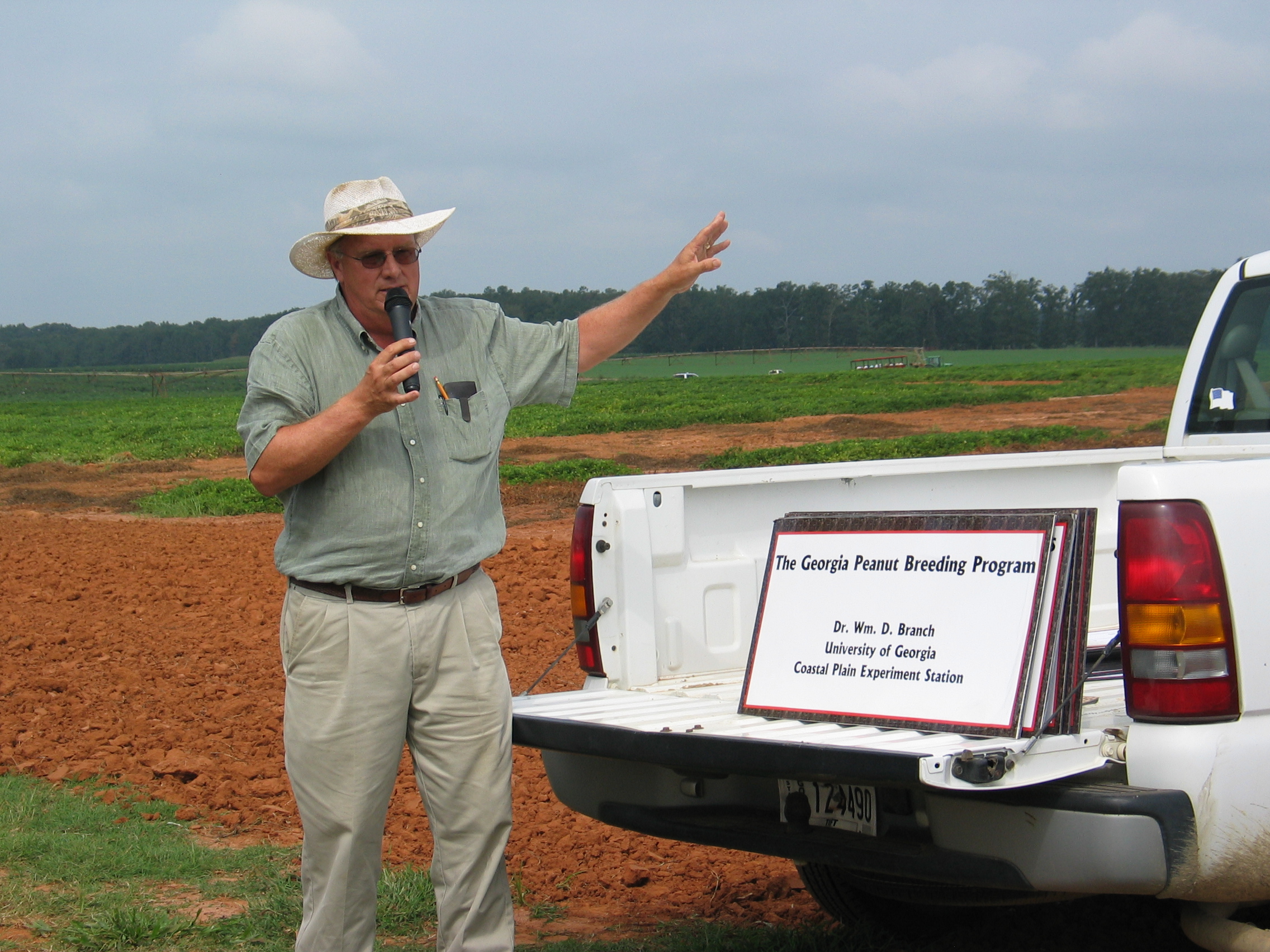 Bill Branch, University of Georgia peanut breeder, discussed the Georgia Peanut Breeding Program to tour attendess while at the Southwest Georgia Research & Education Center in Plains, Ga. The Georgia Peanut Breeding Program is actively involved in the development of improved varieties with desirable traits for increasing dollar value, yield, grade, drought tolerance, better shelling characteristics, longer shelf-life, enhanced flavor, nutritional qualities as well as disease, insect, virus, nematode and aflatoxin resistance. Peanut breeding is a long-term commitment which normally takes 10 years to develop a new variety. Thus, peanut varieties for this new millennium are currently being considered. The most recent varietal releases from the Georgia Peanut Breeding Program have been Georgia Green, Georgia-01R, Georgia-02C, Georgia-03L, Georgia-06G, Georgia Greener, Georgia-07W, Georgia Hi-O/L, Georgia-05E, Georgia-04S, Georgia Browne, Georgia Valencia and Georgia Red. To learn more about each of these varieties, click here to read an article by Dr. Branch that includes a description of each variety.
Bill Branch, University of Georgia peanut breeder, discussed the Georgia Peanut Breeding Program to tour attendess while at the Southwest Georgia Research & Education Center in Plains, Ga. The Georgia Peanut Breeding Program is actively involved in the development of improved varieties with desirable traits for increasing dollar value, yield, grade, drought tolerance, better shelling characteristics, longer shelf-life, enhanced flavor, nutritional qualities as well as disease, insect, virus, nematode and aflatoxin resistance. Peanut breeding is a long-term commitment which normally takes 10 years to develop a new variety. Thus, peanut varieties for this new millennium are currently being considered. The most recent varietal releases from the Georgia Peanut Breeding Program have been Georgia Green, Georgia-01R, Georgia-02C, Georgia-03L, Georgia-06G, Georgia Greener, Georgia-07W, Georgia Hi-O/L, Georgia-05E, Georgia-04S, Georgia Browne, Georgia Valencia and Georgia Red. To learn more about each of these varieties, click here to read an article by Dr. Branch that includes a description of each variety.
Peanut Diseases – CBR & Spraying at Night
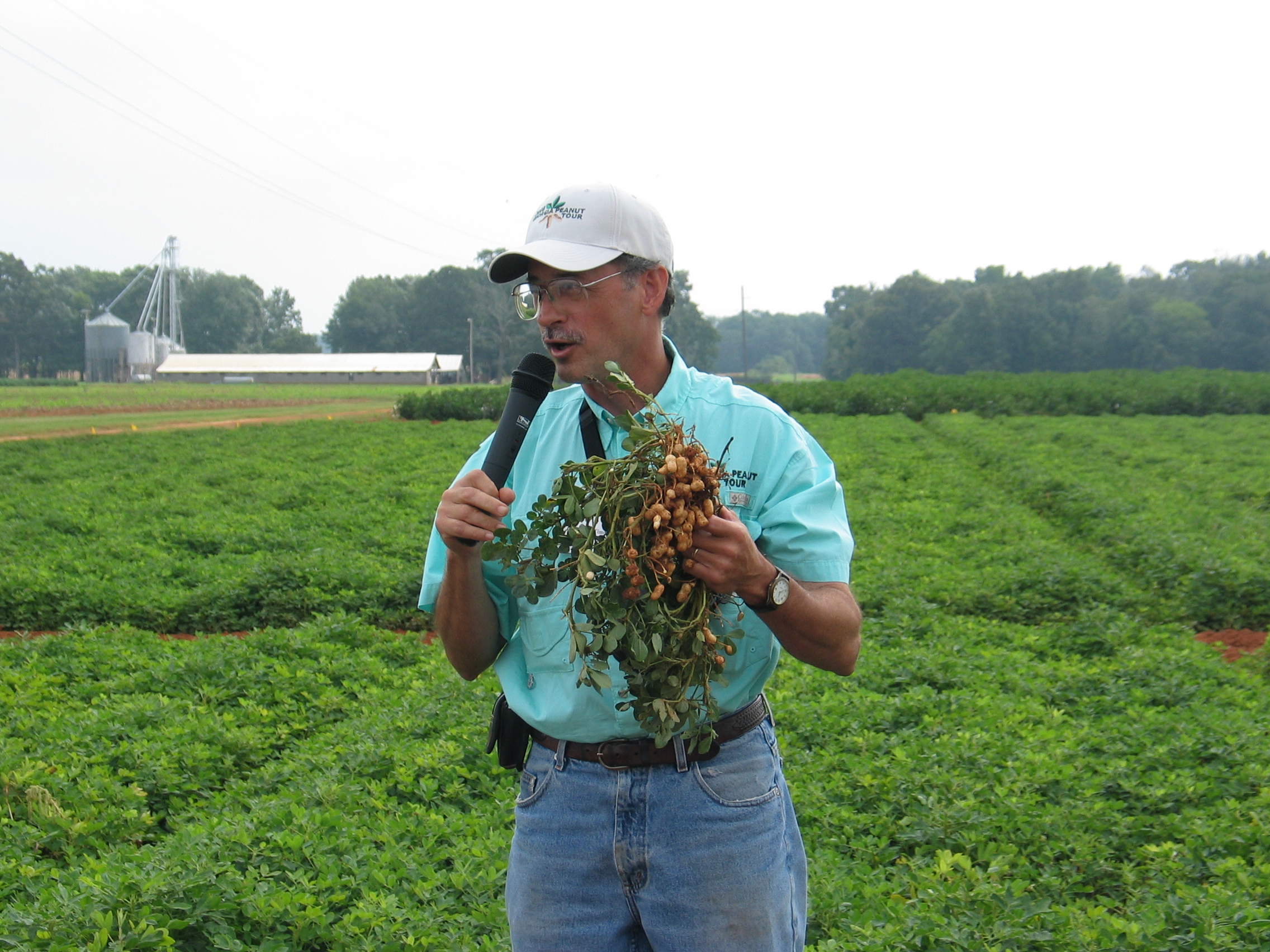 During the stop at the Southwest Georgia Research and Education Center, University of Georgia plant pathologist Tim Brenneman provided an update on soilborne diseases and a new method to use – spraying at night. One soilborne disease, Cylindrocladium black rot (CBR), got its start in Southwest Georgia in peanuts in 1965. CBR is one of those diseases that can be out in the soil all season long but farmers may not see the appearance of this disease until late in the season. Brenneman is researching at the center different approaches to deal with CBR. One of those is through genetic resistance. He is evaluating different peanut varieties for their resistance to CBR. One variety GA-02C has shown resistance to CBR and that is also another reason the variety was planted in the study by Jason Jackson on strip-till beds mentioned in an earlier post. Also, Brenneman is looking at the use of fungicides and new patterns or ways to improve the application process. With CBR it is necessary to wash the fungicide in with irrigation to move the fungicide down to the crown of the plant. Also, he is testing the use of in-furrow fungicide applications at planting. Another research project at the University of Georgia Tifton Campus looks at spraying peanuts at night to control disease such as white mold. At night the peanut leaves fold up and when sprayed the fungicide is able to get down to the soil line. He has also found that the fungicide residue lasts longer in the shade than in the open sun. With sprays at night the residue remains on the plant so in the morning when leaves open (like an umbrella) the canopy provides shade for the spray residue. Spraying at night has been very effective so far but this only marks the second full year of research so the University of Georgia Peanut Team is not recommending this as an official practice for farmers yet. There are also several grower trials throughout the state of Georgia looking at spraying at night to control white mold.
During the stop at the Southwest Georgia Research and Education Center, University of Georgia plant pathologist Tim Brenneman provided an update on soilborne diseases and a new method to use – spraying at night. One soilborne disease, Cylindrocladium black rot (CBR), got its start in Southwest Georgia in peanuts in 1965. CBR is one of those diseases that can be out in the soil all season long but farmers may not see the appearance of this disease until late in the season. Brenneman is researching at the center different approaches to deal with CBR. One of those is through genetic resistance. He is evaluating different peanut varieties for their resistance to CBR. One variety GA-02C has shown resistance to CBR and that is also another reason the variety was planted in the study by Jason Jackson on strip-till beds mentioned in an earlier post. Also, Brenneman is looking at the use of fungicides and new patterns or ways to improve the application process. With CBR it is necessary to wash the fungicide in with irrigation to move the fungicide down to the crown of the plant. Also, he is testing the use of in-furrow fungicide applications at planting. Another research project at the University of Georgia Tifton Campus looks at spraying peanuts at night to control disease such as white mold. At night the peanut leaves fold up and when sprayed the fungicide is able to get down to the soil line. He has also found that the fungicide residue lasts longer in the shade than in the open sun. With sprays at night the residue remains on the plant so in the morning when leaves open (like an umbrella) the canopy provides shade for the spray residue. Spraying at night has been very effective so far but this only marks the second full year of research so the University of Georgia Peanut Team is not recommending this as an official practice for farmers yet. There are also several grower trials throughout the state of Georgia looking at spraying at night to control white mold.

